8 Popular Pet Snake Species
rachasuk/E+ via Getty Images
Are you considering a new scaly pal? From small to large, spotted to striped, pet snakes come in all shapes and patterns—making it easy to find the perfect scaly companion.
Corn Snake (Pantherophis guttatus)
Sometimes called red rat snakes, wild corn snakes are fabulous beginner pet snakes that tolerate appropriate handling.
These beautiful North American natives have vibrant, red to brick-red blotches on their backs with a tan to reddish base color.
They come in a rainbow of color morphs, from axanthic and albino, to lavender and beyond.

Their name comes from their historical association with grain storage, because corn snakes feast on rodents. In this case, it’s rats and mice that get into grain storage to eat harvested corn! Corn snake belly scales also have a checkered pattern that looks a lot like maize.
Ball Python (Python regius)
Easygoing and fairly calm, the ball python is a popular pet because this species is beginner-friendly.
Plus, breeders have developed hundreds of color combinations, called morphs.
With this pet snake, you can take your pick, including albino, blue-eyed leucistic, and orange dream—it’s a designer snake paradise!
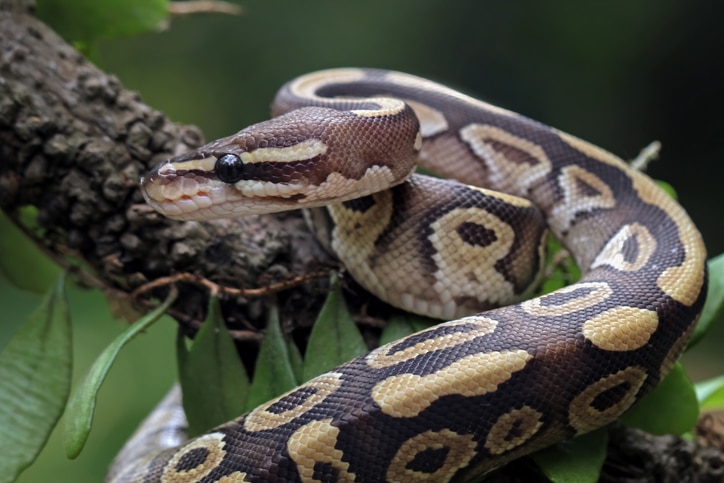
Because these snakes often coil up into a ball when they sleep or feel threatened, many people call these snakes ball pythons. However, in many parts of the world they’re called royal pythons, something their scientific name of Python regius reflects.
Kingsnake (Lampropeltis getula, L. californiae and others)
The most popular pet kingsnake species may be the California kingsnake because of their variable color palette. However, there are others equally deserving of attention. The Mexican black kingsnake, for example, is an all-black affair with shiny scales true to the genus name—Lampropeltis.
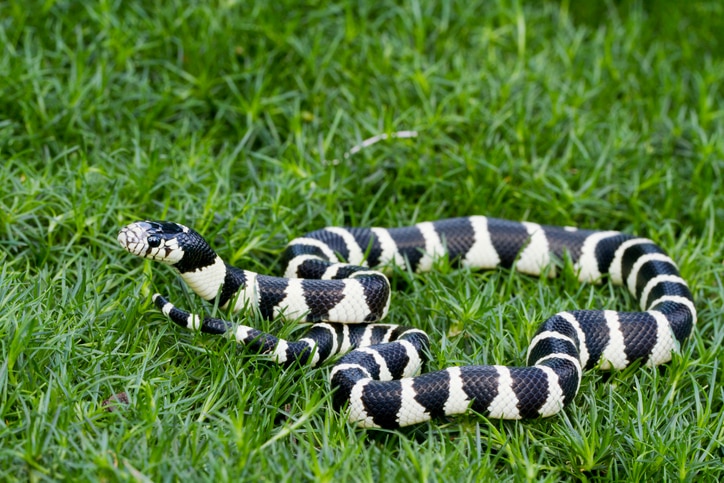
However, it doesn’t matter which kingsnake species you take home as a pet. They’re all generally docile, low-maintenance, and highly adaptable. They’re also very strong and constrict their prey—which, in the wild, often includes other snake species, like rattlesnakes.
This dietary preference is why they’re called kingsnakes, because like the king cobra, snakes make up a large percentage of their wild diet. So while they’re happy to accept a typical snake diet of frozen/thawed mice or rats, your kingsnake won’t turn down a frozen/thawed snake hatchling.
Milk Snake (Lampropeltis triangulum ssp.)
All milk snakes are kingsnakes, but not all kingsnakes are milk snakes.
A type of kingsnake, milk snakes sport various combinations of shiny scales in black, red, white, and sometimes orange, gray, or yellow. In fact, Lampropeltis means “shiny shield.”
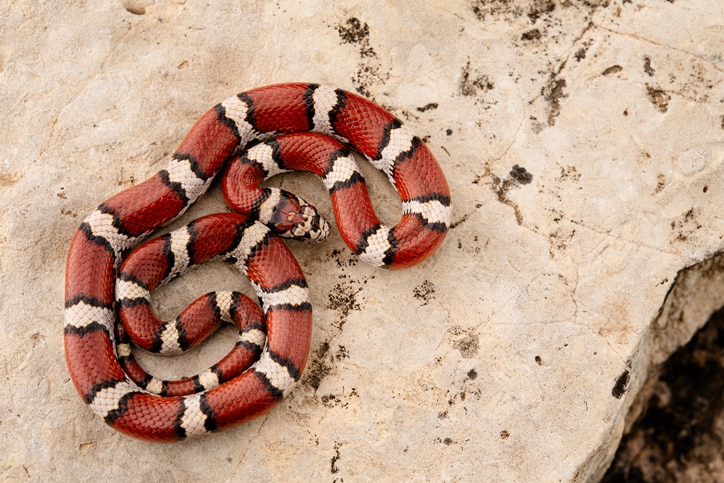
Although their colors and patterns are anything but milky, their name came from the idea that they snuck into barns and drank milk directly from cows.
However, we now know snakes don’t drink milk. The milk snakes actually hunt rodents that live in barns and then look for a warm place to rest after a meal. Milk snakes are cool pet snakes that are usually more active at night.
Garter Snake (Thamnophis sirtalis spp.)
Small but active and social, a garter snake is a lot of personality in a small pet snake package.
Thin and entertaining, you can’t keep just one. Garter snakes are more social than most other snake species, so some experienced snake pet parents house two garter snakes in the same enclosure.
Wild garter snakes live from Canada to Central America. There are dozens of subspecies and a dizzying array of color patterns, from basic brown and yellow to vivid blue and red.
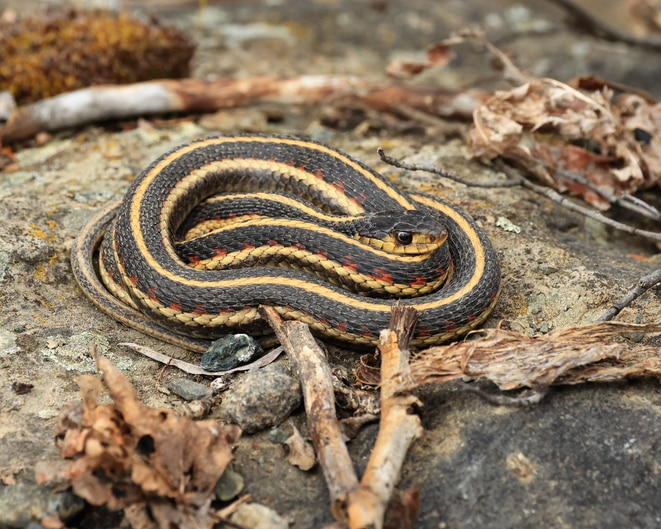
One of the most amazing snake-related events happens in Canada every spring. Garter snakes in the Narcisse Snake Dens in Manitoba emerge from brumation, a state of dormancy during colder months that is similar to hibernation, in a frantic breeding frenzy. It’s a spectacle that most snake lovers want to see at least once.
Water Snake (Nerodia spp.)
If you have ever wondered how goofy a snake can look, check out the water snake. This North American native’s somewhat oddly placed eyes are situated more on top of their head than the sides. So, when they flatten their heads out, it elevates the funny expression.
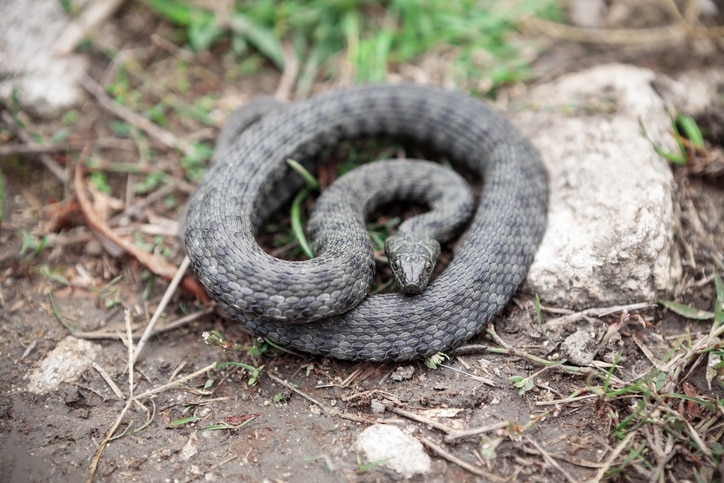
When you want an entertaining pet snake and have enough room to set up an awesome semiaquatic enclosure, the water snake is a great choice for a pet snake.
Water snakes are semiaquatic and spend part of their time in the water and the rest either basking or resting.
Green Tree Python (Morelia viridis)
The stunning green tree python may look like an emerald tree boa, but these two snakes are a perfect example of convergent evolution, meaning they evolved on different continents but look and behave similarly.
Green tree pythons are better display snakes than buddies for you to carry around. They’re more prone to biting moving objects—especially at night when they’re most active.
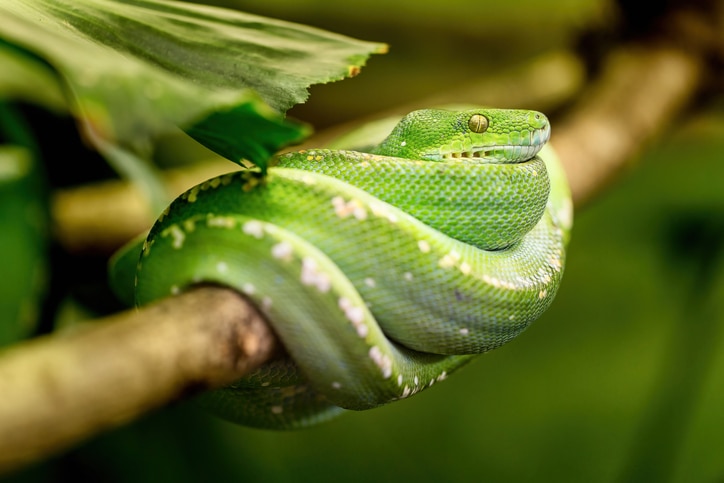
When green tree pythons hatch, their colors are yellow, red, or sometimes brownish. They only become green or blue as they mature throughout the first year or two of life.
They live in the trees of their native Indonesian islands, grabbing small animals and sometimes snatching birds out of the air for their meals. While their large, well-developed jaw muscles give them the appearance of a venomous snake, they’re nonpoisonous
Brazilian Rainbow Boa (Epicrates cenchria)
Brazilian rainbow boas get their name from shiny, iridescent scales that refract light like thousands of tiny prisms. Purines in the cells of their skin cause the beautiful effect, and scientists call it structural coloration. The result is a shimmering skin that shines every time light hits the snake.

On top of all that? Brazilian rainbow boas are big but manageable snakes that hunt using heat sensing pits that line their lips. Similar to pit vipers and some python species, heat sensing pits guide the Brazilian rainbow boa to a meal—even if it’s pitch dark.
